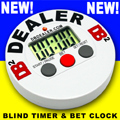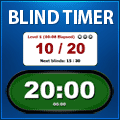|
|
Poker Chip Color-upAs your game progresses, it may be necessary to remove (color-up) the lower denomination poker chips from the table. When a player has a couple thousand in chips and the blinds are 300/600 ... those stacks and stacks of Red (5) chips are only getting in the way and taking up space on the poker table. From Roberts Rules of Poker, Section 15 - Tournaments The lowest denomination of chip in play will be removed from the table when it is no longer needed in the blind or ante structure. All lower-denomination chips that are of sufficient quantity for a new chip will be changed up directly. The method for removal of odd chips is to deal one card to a player for each odd chip possessed. Cards are dealt clockwise starting with the 1-seat, with each player receiving all cards before any cards are dealt to the next player. The player with the highest card by suit gets enough odd chips to exchange for one new chip, the second-highest card gets to exchange for the next chip, and so forth, until all the lower-denomination chips are exchanged. A player may not be eliminated from the event by the chip-change process. If a player has no chips after the race has been held, he will be given a chip of the higher denomination before anyone else is awarded a chip. If an odd number of lower-denomination chips are left after this process, the player with the highest card remaining will receive a new chip if he has half or more of the quantity of lower-denomination chips needed, otherwise nothing. From the TDA rules (Tournament Directors Association) When it is time to color-up chips, they will be raced off with a maximum of one chip going to any player. The chip race will always start in the No.1 seat. A player cannot be raced out of a tournament. In the event that a player has only one chip left, the regular race procedure will take place. If that player loses the race, he will be given one chip of the smallest denomination still in play. I'll explain the poker color-up process using an example ... There are five players remaining. Each player exchanges (from the bank) all his existing Red (5) chips for as many Green (25) chips as possible. After doing so - Seat 1 (small blind) has 3 Red (5) chips that he could not exchange for a Green (25) chip, Seat 2 (big blind) has 2 Red chips, Seat 3 has 1 Red chip, Seat 4 has 4 Red chips, and Seat 5 has 3 Red chips. The dealer (or Tournament Director) deals 3 cards face-up to Seat 1. The dealer then deals 2 cards to Seat 2, 1 card to Seat 3, 4 cards to Seat 4, and 3 cards to Seat 5. The dealer then collects all 13 Red (5) chips. The dealer has collected 13 Red (5) chips and exchanges these (from the bank) for 2 Green (25) chips but still has 3 Red (5) chips remaining. Since 3 Red (5) chips is greater than half of a Green (25) chip - a third Green (25) will be given out. The dealer exchanges (from the bank) the 3 Red (5) chips for 1 Green (25) chip. The dealer gives one Green (25) chip to the player with the highest card (ace of spades is highest). The dealer then gives the second Green (25) chip to a different player with the next highest card and then gives the third Green (25) chip to an entirely different player with the next highest card. A player cannot be eliminated from the tourney by a color-up. Using the same example as above, assume that Seat 4 with 4 Red (5) chips had only 20 chips remaining in the tourney ... those same four chips that just went into the color-up. Seat 4 now has zero chips remaining on the table. Let's also assume that Seat 4 was dealt the following four cards for his chips - 2s,5h,4d,2c (this guy is a real loser!). He has the four lowest cards of any player at the table and he should be given zero chips from the color-up but ... he cannot be eliminated from the tournament by a color-up so ... he must be given one Green (25) chip from the bank. The three color-up chips are then awarded. In home games, it is acceptable to postpone your color-ups until your next scheduled break and ... some home games have no race-off at all. The players exchange as many of their low denomination chips as they possibly can (from the bank) and then simply leave their remaining low denomination chips on the table with their other chips. As more and more of the low denomination chips are accumulated by individual players, you can cash them in for higher denomination chips. Hint: At the beginning of your color-up, ask the chip leader at each table to buy as many small denomination chips as possible from all the other players at that table. This will speed up the process of your poker chip color-up because your chip leader(s) will now have the vast majority of the small denomination chips. Here is an HPT Forums post about an alternate (easier) method for a poker chip color-up. |
Online Poker Guide
Hand Converter
Holdem strategy
Freeroll tournaments
Poker calculator
Online poker
Poker rooms
> poker pokeren
> iDeal poker
> online casino
> iDeal casino
> casino casinos
> casino bonus
Get Bonus code Titan Poker, and full tilt poker referral code or max bonus to the full tilt referral code. Best ultimate bet referral code sign up bonus doyles room promo code or poker host bonus code























